
An electronic glove has recently been developed by researchers at Purdue University that can be worn over a prosthetic hand to provide sensory perception. This glove not only gives the prosthesis a more humanlike texture, but it provides the wearer with the ability to sense pressure, hydration, and temperature as well. This work was published on August 30 in NPJ Asia Materials.
Many hand amputees face difficulty in their daily lives that requires them to use prosthetic hands for the rest of their lives. Though the typical prosthetic device can restore the amputee’s mobility, it is unable to restore their tactile senses like this new e-glove. This glove also has the potential to improve the user’s mental health and quality of life by making their prosthetic hand function more realistically.
This electronic glove uses thin, flexible sensors and silicon-based circuit chips on a nitrile glove that is commercially available. This glove is connected to a novel wristwatch, which displays in real-time the sensory data it is perceiving.
This glove was developed by Chi Hwan Lee, an assistant professor in Purdue’s College of Engineering, in collaboration with other scientists from Purdue, the University of Georgia and the University of Texas.
“We developed a novel concept of the soft-packaged, sensor-instrumented e-glove built on a commercial nitrile glove, allowing it to seamlessly fit on arbitrary hand shapes,” explained Lee. “The e-glove is configured with a stretchable form of multimodal sensors to collect various information such as pressure, temperature, humidity and electrophysiological biosignals, while simultaneously providing realistic human hand-like softness, appearance and even warmth.”
Lee and colleagues are optimistic that the lifelike appearance and capabilities of their glove will improve the lives of hand amputees by making them more comfortable in social settings. The glove has lifelike fingerprints, fingernails, and comes in different skin tones to make the device look as realistic as possible.
“The prospective end user could be any prosthetic hand users who have felt uncomfortable wearing current prosthetic hands, especially in many social contexts,” Lee said.
The manufacturing process behind this glove is inexpensive and scalable at high volumes, making it an affordable option for users.
Lee has worked to patent this technology with the Purdue Research Foundation Office of Technology Commercialization alongside Min Ku Kim, an engineering doctoral student at Purdue and a co-author on the paper. The two are searching for partners to work with their glove in clinical trials, as well as prosthetic experts to validate their device and help optimize its design. They wanted to get some help on where to submit invention ideas like this.
“My group is devoted to developing various wearable biomedical devices, and my ultimate goal is to bring these technologies out of the lab and help many people in need. This research represents my continued efforts in this context,” Lee concluded.
E-Glove: Electronic glove from @PurdueResFound offers ‘humanlike’ features such as softness, warmth, appearance & sensory perception, i.e the ability to sense pressure, temp. & hydration for prosthetic hand users. https://t.co/Qe4padtFp4
— Pinaki Dasgupta ,MBA ✨ (@Seanku) September 4, 2019







 © 2025 Mashup Media, LLC, a Formedics Property. All Rights Reserved.
© 2025 Mashup Media, LLC, a Formedics Property. All Rights Reserved.